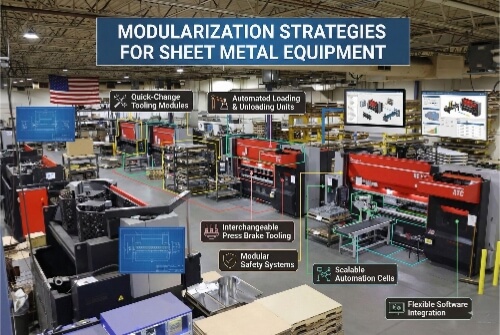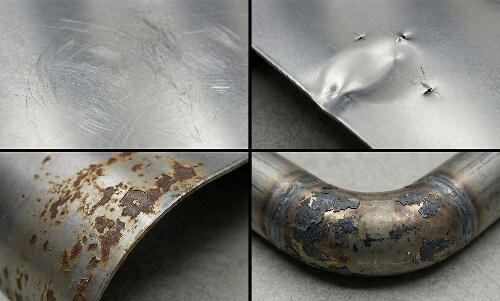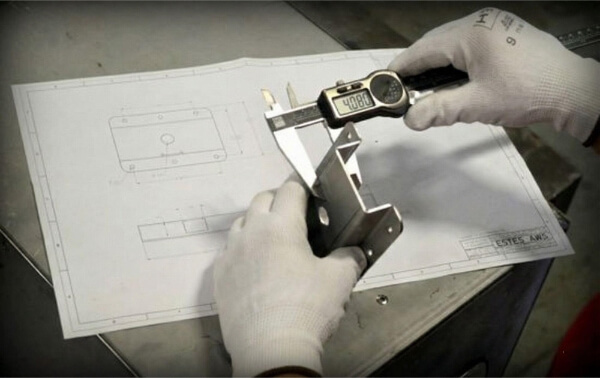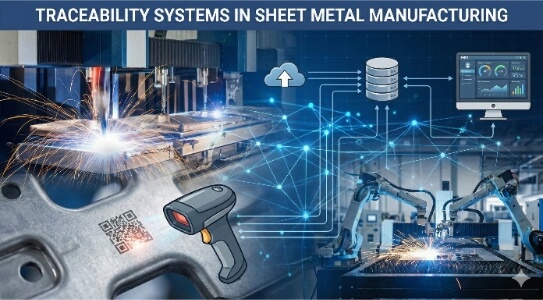Каждый производитель сталкивается с тремя важнейшими проблемами: получение точных срезов, поддержание стабильного качества и соблюдение жестких сроков производства. При ручной резке металла часто приходится догонять, что приводит к отходам материала, дорогостоящим ошибкам и задержкам в реализации проекта. Резка металла с ЧПУ произвела революцию в производстве, решив именно эти проблемы.
Хотите узнать, как эта передовая технология может расширить ваши производственные возможности? Давайте рассмотрим основные процессы, области применения и преимущества, которые делают резку металла с ЧПУ незаменимой частью современного производства.
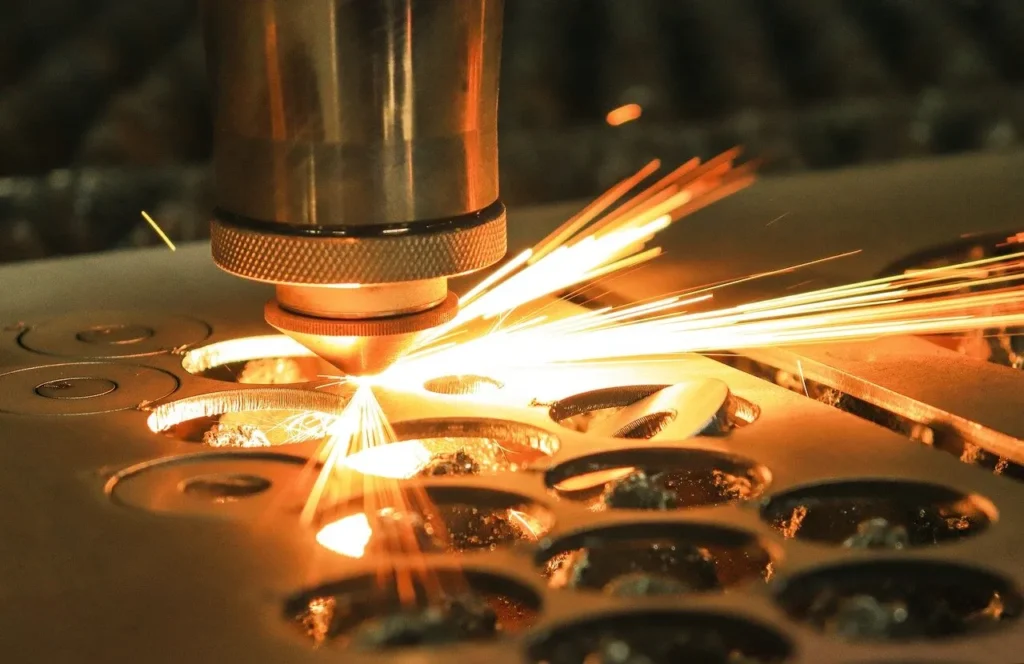
Основы резки металла с ЧПУ
Компьютерное числовое управление произвело революцию в металлообработке, внедрив автоматизированную точность в производство. Эта технология устраняет разрыв между проектированием и производством, превращая цифровые чертежи в физические компоненты.
Что такое резка металла с ЧПУ?
Резка металла с ЧПУ превращает необработанный металл в готовые детали путем контролируемого удаления материала. В этом процессе используются специализированные режущие инструменты, которые следуют по точным, управляемым компьютером траекториям. Этот метод позволяет создавать все: от простых кронштейнов до сложных аэрокосмических компонентов.
Типичная операция резки металла с ЧПУ начинается с разработки проекта CAD. Система преобразует этот проект в машинные инструкции, которые затем направляют режущие инструменты для планомерного удаления материала. В результате получаются детали исключительной точности, часто требующие минимальной последующей обработки.
Принцип работы станков с ЧПУ
Думайте о станках с ЧПУ как о высококоординированных системах, работающих в полной гармонии. Компьютерный мозг интерпретирует запрограммированные инструкции. Затем он управляет механическими компонентами с микросекундной точностью.
Во время работы станок отслеживает бесчисленные переменные. Скорость резания, положение инструмента и скорость подачи материала автоматически изменяются по мере необходимости. Усовершенствованные датчики предотвращают аварии и поддерживают оптимальные условия резки.
Типы станков с ЧПУ, используемых для резки металла
Каждый тип станков с ЧПУ служит для решения конкретных производственных задач. Фрезерные станки отлично справляются с созданием сложных трехмерных форм и деталей. Токарные станки производят цилиндрические детали с невероятной точностью. Многоосевые станки объединяют эти возможности для максимальной универсальности.
В современном производстве часто используются специализированные станки с ЧПУ. Пятикоординатные фрезерные станки создают сложные аэрокосмические компоненты. Токарные станки швейцарского типа производят миниатюрные медицинские приборы. Большие портальные станки обрабатывают массивные промышленные детали. Благодаря такому разнообразию производители могут выбрать подходящий инструмент для каждой задачи.
Основные процессы резки металла с ЧПУ
Каждый метод резки с ЧПУ отвечает конкретным производственным потребностям. Эти процессы отличаются по скорости, точности и совместимости с материалами. Выбор зависит от требований вашего проекта, типа материала и объема производства.
Фрезерование: Определение и обзор процесса
Фрезерование Для удаления металла из заготовок используются вращающиеся инструменты. Режущий инструмент перемещается по поверхности материала в различных направлениях, создавая плоские поверхности, сложные 3D-формы и детали.
Токарная обработка: Как работает токарная обработка металла
Превращение вращает заготовку, а неподвижный режущий инструмент придает ей форму. Этот процесс позволяет создавать цилиндрические детали с высокой точностью. Обычно используются валы, болты и другие круглые детали.
Сверление: Роль сверления при резке с ЧПУ
Сверление с ЧПУ Создает точные отверстия в металлических заготовках. Компьютерное управление обеспечивает постоянство диаметра и глубины отверстий. Современные станки могут сверлить под углом и автоматически создавать сложные узоры отверстий.
Электроэрозионная обработка (EDM)
EDM режет металл с помощью электрических искр в диэлектрической жидкости. Этот процесс позволяет обрабатывать закаленную сталь и выполнять сложные внутренние разрезы. При этом достигаются очень жесткие допуски без применения механической силы.
Лазерная резка: Обзор
Лазерная резка расплавляет или испаряет металл с помощью сфокусированных световых лучей. Этот метод позволяет получить чистые края и сложные детали. Он отлично подходит для листового металла и тонких материалов.
Гидроабразивная резка: Преимущества и области применения
Струи воды смешивают воду с абразивными частицами для резки металла. Этот процесс холодной резки предотвращает тепловое искажение. Он позволяет резать толстые материалы, сохраняя их свойства.
Плазменная резка: Популярный метод изготовления металла
Плазменная резка Использует ионизированный газ для разрезания проводящих металлов. Этот процесс обеспечивает высокую скорость резки толстых материалов. Он позволяет сбалансировать стоимость и качество для многих промышленных применений.
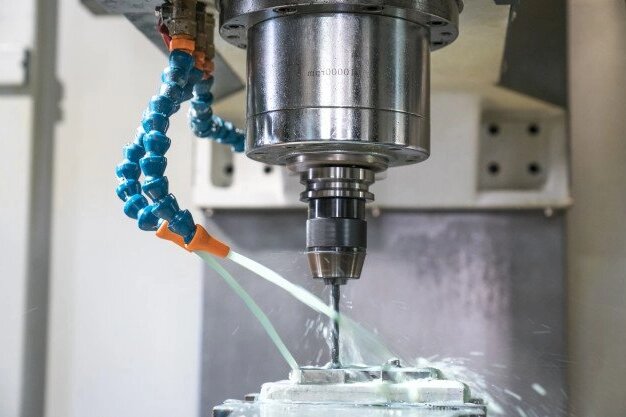
Какие материалы можно резать на станках с ЧПУ?
Возможности резки металла зависят от типа и толщины материала. Каждый метод ЧПУ соответствует определенным свойствам металла и требованиям задания. Правильный метод резки позволяет сбалансировать точность, скорость и экономическую эффективность.
Вот краткая справочная таблица стандартных материалов и их возможностей резки:
| Тип материала | Лазерная резка | Штамповка с ЧПУ | Фрезерование с ЧПУ | Плазменная резка |
|---|---|---|---|---|
| Алюминий | До 10 мм | До 6 мм | Без ограничения толщины* | До 50 мм (начало кромки) |
| Мягкая сталь | До 32 мм (1,25") | 0,5-6 мм | Без ограничения толщины* | До 38 мм |
| Нержавеющая сталь | До 12 мм | 0,5-6 мм | Без ограничения толщины* | До 25 мм |
| Латунь | До 6 мм | До 4 мм | Без ограничения толщины* | До 20 мм |
| Медь | До 4 мм | До 3 мм | Без ограничения толщины* | До 20 мм |
Преимущества резки металла с ЧПУ
В условиях современной конкуренции изготовление металлических изделий требует точности и эффективности. Технология ЧПУ отвечает этим требованиям, сочетая передовую автоматизацию с надежными производственными возможностями. В этом разделе рассматриваются основные преимущества, которые делают резку металла с ЧПУ краеугольным камнем современного производства.
Повышенная точность и согласованность
Цифровое управление обеспечивает идеальное соответствие каждого отреза спецификациям. Станки поддерживают точность в пределах микронов на протяжении всего производственного цикла. Такая точность позволяет добиться следующих результатов:
- Повторяющиеся результаты для тысяч деталей
- Минимальные различия между партиями
- Снижение количества проблем с контролем качества
- Идеальная подгонка и сборка готовых изделий
Экономическая эффективность и сокращение отходов
Инновационное программирование и автоматизация значительно снижают эксплуатационные расходы. Точность станков с ЧПУ сводит к минимуму отходы материалов. Результаты:
- Снижение трудозатрат на деталь
- Снижение количества брака материалов
- Меньше бракованных деталей
- Оптимизированное использование материалов
- Снижение требований к доработке
Высокоскоростное производство и сроки выполнения заказа
Станки с ЧПУ работают быстрее, чем ручные методы, сохраняя при этом качество. Они работают непрерывно с минимальным временем простоя. Преимущества включают:
- Возможность производства 24/7
- Быстрое изменение настроек
- Быстрая разработка прототипов
- Ускоренное выполнение заказов
- Оптимизация производственных графиков
Гибкость в проектировании и создании прототипов
Цифровое управление позволяет быстро вносить изменения в конструкцию и изготавливать продукцию на заказ. Производители могут быстро адаптироваться к требованиям рынка. Это создает:
- Легкое обновление дизайна
- Быстрые итерации прототипов
- Производство деталей на заказ
- Возможность создания сложных геометрических форм
- Многочисленные варианты материалов
Области применения резки металла с ЧПУ
Резка металла с ЧПУ охватывает множество отраслей промышленности, создавая детали от важнейших аэрокосмических компонентов до сложных произведений искусства. Технология адаптируется к различным производственным потребностям, от единичных прототипов до крупносерийного производства.
Аэрокосмическая и автомобильная промышленность
В этих отраслях требуется высочайшая точность и надежность металлических деталей. Резка с ЧПУ отвечает строгим отраслевым стандартам благодаря:
- Компоненты двигателя с жесткими допусками
- Конструктивные детали самолетов
- Компоненты тормозной системы
- Детали трансмиссии
- Нестандартные элементы шасси
Производство медицинских изделий
Медицинское производство требует исключительной чистоты и точности. Станки с ЧПУ производят:
- Хирургические инструменты
- Компоненты имплантатов
- Детали диагностического оборудования
- Корпуса для медицинского оборудования
- Индивидуальные компоненты протезов
Резка металла с ЧПУ в электронике
В современной электронике используются точные металлические компоненты. К числу распространенных применений относятся:
- Радиаторы
- Шасси и корпуса
- Крепеж для монтажа печатной платы
- Корпуса разъемов
- Экраны от электромагнитных помех
Изготовление промышленных деталей на заказ
Промышленное оборудование нуждается в прочных и точных компонентах. Резка с ЧПУ создает:
- Запасные части
- Нестандартные компоненты оборудования
- Оборудование для производственных линий
- Инструменты для обработки материалов
- Специализированная оснастка
Резка с ЧПУ в искусстве и скульптуре
Художники используют технологию ЧПУ, чтобы расширить творческие границы. Области применения включают:
- Настенное искусство из металла
- Масштабные скульптуры
- Архитектурные элементы
- Декоративные панели
- Индивидуальные вывески
Сельскохозяйственное и животноводческое оборудование
Рамы животноводческих машин, таких как следующие, требуют точной резки:
- Стойла для лошадей
- Оборудование для конного сарая
- Приют для лошадей
Заключение
Резка металла с ЧПУ революционизирует современное производство благодаря цифровой точности. Технология обеспечивает превосходную точность, скорость и универсальность при работе с различными материалами. Успех в резке с ЧПУ достигается благодаря правильному подбору процесса в соответствии с конкретным материалом и потребностями проекта.
Часто задаваемые вопросы
Сколько стоит металл с ЧПУ?
Стоимость резки металла с ЧПУ зависит от нескольких ключевых факторов. Тип и толщина материала влияют на время резки и износ инструмента. Сложность деталей влияет на требования к программированию и настройке. Время работы станка обычно составляет от $75 до $250 в час.
Насколько точна резка металла с ЧПУ?
Станки с ЧПУ достигают удивительной точности в операциях по резке металла. Стандартные допуски достигают ±0,001 дюйма (0,025 мм) для большинства задач. При необходимости высокоточные станки могут обеспечить еще более жесткие допуски.
Какую толщину металла может разрезать станок с ЧПУ?
Возможности резки металла по толщине зависят от процесса и материала. Лазерные системы работают со сталью толщиной до 1,25 дюйма, плазменные резаки - с алюминием толщиной до 3 дюймов, а водяные струи разрезают металл толщиной в несколько дюймов.
Как резка с ЧПУ повышает эффективность производства?
Резка с ЧПУ оптимизирует производство за счет автоматизации и точности. Станки работают непрерывно без усталости. Хранение программ позволяет быстро менять задания. Многоосевые возможности позволяют выполнять сложные детали за один установ.
Цифровые рабочие процессы сокращают количество ошибок и отходов. Автоматизированное управление инструментами максимально увеличивает время безотказной работы. Встроенный контроль обеспечивает стабильное качество. Все эти функции позволяют повысить производительность при соблюдении высоких стандартов.
Привет, я Кевин Ли

Последние 10 лет я занимался различными формами изготовления листового металла и делился здесь интересными идеями из своего опыта работы в различных мастерских.
Связаться

Кевин Ли
У меня более десяти лет профессионального опыта в производстве листового металла, специализирующегося на лазерной резке, гибке, сварке и методах обработки поверхности. Как технический директор Shengen, я стремлюсь решать сложные производственные задачи и внедрять инновации и качество в каждом проекте.

